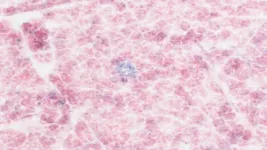(Press-News.org) Researchers have developed a way to use ultrasound to predict whether a pregnant person is at risk of delivering a baby prematurely, which occurs in upward of 10% of pregnancies in the U.S.
The new method — the result of more than 20 years of collaboration between researchers in nursing and engineering at University of Illinois Chicago and University of Illinois Urbana-Champaign — measures microstructural changes in a woman’s cervix using quantitative ultrasound. The ultrasound method works as early as 23 weeks into a pregnancy, according to the research, which is published in the American Journal of Obstetrics & Gynecology Maternal Fetal Medicine.
The current method for assessing a woman’s risk of preterm birth is based solely on whether she has previously given birth prematurely. This means there has been no way to assess risk in a first-time pregnancy.
“Today, clinicians wait for signs and symptoms of a preterm birth,” such as a ruptured membrane, explained lead author Barbara McFarlin, a professor emeritus of nursing at UIC. “Our technique would be helpful in making decisions based on the tissue and not just on symptoms.”
In a study of 429 women who gave birth without induction at the University of Illinois Hospital, the new method was effective at predicting the risk of preterm births during first-time pregnancies. And for women who were having a subsequent pregnancy, combing the data from quantitative ultrasound with the woman’s delivery history was more effective at assessing risk than just using her history.
The new approach differs from a traditional ultrasound where a picture is produced from the data received. In quantitative ultrasound, a traditional ultrasound is performed but the radio frequency data itself is read and analyzed to determine tissue characteristics.
The study is the culmination of a research partnership that began in 2001 when McFarlin was a nursing PhD student at UIC. Having previously worked as a nurse midwife and sonographer, she had noticed that there were differences in the appearance of the cervix in women who went on to deliver preterm. She was interested in quantifying this and discovered that “no one was looking at it.”
She was put in touch with Bill O’Brien, a UIUC professor of electrical and computer engineering, who was studying ways to use quantitative ultrasound data in health research. Together, over the past 22 years, they established that quantitative ultrasound could detect changes in the cervix and, as McFarlin had suspected long ago, that those changes help predict the risk of preterm delivery.
The preterm birth rate hovers around 10-15% of pregnancies, O’Brien said. “That’s a very, very high percentage to not know what is happening,” he said.
If a clinician could know at 23 weeks that there was a risk of preterm birth, they would likely conduct extra appointments to keep an eye on the fetus, the researchers said. But since there had previously been no routine way to assess preterm birth risk this early, there have been no studies to show what sort of interventions would be helpful in delaying labor. This study, O’Brien explains, will allow other researchers to “start studying processes by which you might be able to prevent or delay preterm birth.”
The research was funded by the National Institutes of Health’s National Institute of Child Health and Human Development. Additional coauthors are UIC nursing PhD student Michelle Villegas-Downs; UIUC statistics PhD student Mehrdad Mohammadi and statistics professor Douglas Simpson; and engineering professor Aiguo Han at Virginia Tech.
Written by Emily Stone
END
Ultrasounds can help predict the risk of preterm births, new research shows
2024-01-24
ELSE PRESS RELEASES FROM THIS DATE:
Exposure to flame retardants linked to premature birth, higher birth weight
2024-01-24
(SACRAMENTO, Calif.) — In the largest study of its kind, researchers at UC Davis Health found that exposure to organophosphate ester flame retardants during pregnancy was associated with preterm birth, especially among females. The chemicals were also linked to higher birth weight, a concern for increased obesity risk. The major new research study was published in Environmental Health Perspectives.
“The importance of this study lies in unraveling the potential impact of exposure to environmental chemicals during pregnancy on fetal development. Our findings guide our understanding of how these chemicals may be silently seeding lasting challenges ...
How a protein fights off bacteria
2024-01-24
The human immune system is constantly fending off a wide range of invaders – a feat that requires a diverse array of cellular troops and molecular weaponry. Although a great deal is already known about immune defense cells and the strategies they employ, many molecular details have remained elusive. Now a research team led by Professor Oliver Daumke, a lab head at the Max Delbrück Center, has managed to unravel the main activation mechanism of GBP1, a protein that plays a pivotal role in combating certain bacteria. They report in “The EMBO ...
Breakthrough technology offers promising treatment for ischemic retinopathy
2024-01-24
A groundbreaking technology with immense potential in treating ischemic retinopathy in premature infants and diabetic patients has been developed by Professor Byoung Heon Kang and his research team in the Department of Biological Sciences at UNIST, in collaboration with Professor Dong Ho Park’s team at Kyungpook National University Hospital. Ischemic retinopathy, characterized by the breakdown of the blood-retinal barrier and abnormal blood vessel growth, often leads to vision impairment and loss. The researchers have identified the critical role of a mitochondrial ...
Death rate higher than expected for patients with functional, nonepileptic seizures
2024-01-24
The death rate for patients with functional, nonepileptic seizures is higher than expected, with a rate comparable to epilepsy and severe mental illness, a Michigan Medicine-led study finds.
A team of researchers reviewed data from 700 patients who were diagnosed with functional seizures, also called psychogenic or nonepileptic seizures, between 2014 and mid-2023 and followed for a median of 15 months.
It is the largest study of its kind in the United States, matching international studies in Australia, Denmark, Sweden and the United Kingdom, all of which have nationalized health care systems.
Of the 700 patients with functional ...
National Science Foundation and The Kavli Foundation partner on call for research proposals in neurobiology and changing ecosystems
2024-01-24
The Kavli Foundation and the U.S. National Science Foundation (NSF) Directorate for Biological Sciences' Division for Integrative Organismal Systems have joined forces to launch a grant program in neurobiology and changing ecosystems. Research in this emerging field has great potential to reveal novel scientific insights that will accelerate understanding of basic biology in neural adaptation and resilience at the molecular, biophysical, cellular, and circuit levels.
“NSF’s partnership with The Kavli Foundation will enable the U.S. to advance research in this emerging and understudied field,” remarked Denise Dearing, Division ...
Facial recognition app for dogs developed to help in fight against rabies
2024-01-24
A new mobile phone-based facial recognition application for dogs has the potential to significantly improve rabies vaccination efforts in endemic areas like Africa and Asia, according to a study on the research published in the journal Scientific Reports.
Led by researchers at Washington State University, a team used the app to test its effectiveness at a rabies vaccination clinic in rural Tanzania where they microchipped, vaccinated and registered dogs. The technology proved remarkably accurate during a subsequent visit to surrounding villages once poor images and improperly recorded ...
New study unveils how plants control the production of reactive oxygen species
2024-01-24
Reactive oxygen species (ROS) are highly reactive molecules containing oxygen. These compounds, which are normal byproducts of biological processes in all living organisms such as aerobic respiration as well as photosynthesis, are highly toxic. In most cases, ROS damage cellular machinery and can trigger a harmful stress response if their levels are not kept in tight check; this is why antioxidants are an important part of our diet.
However, over the past few decades, scientists have discovered that ROS are often intentionally ...
Rice study unlocks breakthrough for breast cancer bone metastases
2024-01-24
HOUSTON – (Jan. 24, 2023) – Rice University researchers in the lab of chemist Han Xiao have identified a promising new immunological pathway to treat stubborn bone tumors, one of most prevalent forms of metastases in breast cancer patients.
“More than 70% of people with metastatic breast cancer will see the cancer cells move to bone, which can lead to skeletal-related events like bone pain, fractures, and hypercalcemia,” said Yixian Wang, a Rice graduate student in the Han lab who is a lead author on a study published in Proceedings of the National Academy of Sciences. ...
The fountain of youth is … a T cell?
2024-01-24
The fountain of youth has eluded explorers for ages. It turns out the magic anti-aging elixir might have been inside us all along.
Cold Spring Harbor Laboratory (CSHL) Assistant Professor Corina Amor Vegas and colleagues have discovered that T cells can be reprogrammed to fight aging, so to speak. Given the right set of genetic modifications, these white blood cells can attack another group of cells known as senescent cells. These cells are thought to be responsible for many of the diseases we grapple with later in life.
Senescent cells are those that stop replicating. As we age, they build up in our bodies, ...
Infants born to COVID-infected mothers have triple the risk of developing respiratory distress
2024-01-24
New UCLA-led research finds that infants born full term to mothers who were infected with COVID-19 during pregnancy had three times the risk of having respiratory distress compared with unexposed infants, even though they themselves were not infected with the virus. The risk was significantly lower when the mothers infected during pregnancy were previously vaccinated.
The researchers found that in-utero exposure to SARS-CoV-2 sparked an “inflammatory cascade” in the infants, increasing the risk of a breathing disorder that most often ...






